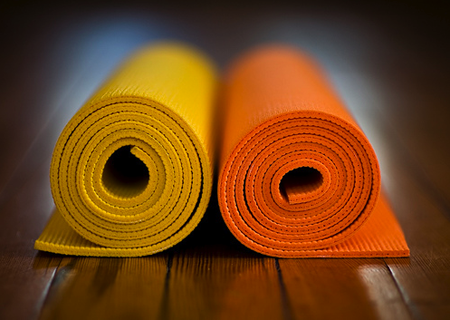Life Cycle is a series of posts that takes a closer look at the stuff we use and love.

It's the end of class. You're breathing deeply, surrendering the weight of your body into your yoga mat. Breathing in...and out. Letting yourself go.
Who doesn't feel better after a yoga class? Yoga is the union of the body, mind and spirit. It stabilizes the nervous system, decreases blood pressure, increases flexibility and endurance, and opens you up in ways that you may not have imagined.
Simran used to be a yoga teacher. She loves the practice even though she hasn't spent much time on her mat lately. ("Yoga on the inside, baby!") Sarah gets her yoga on every week and knows it does her body good.
But, as any student knows, the real practice starts when you walk out the door. That's also where the rubber hits the road and your practice takes its toll on the environment.
Oh brother, that again? Yes, my dear yogin, that.
The majority of yoga mats are manufactured in Taiwan and made of poly-vinyl chloride, or PVC. PVC makes a great mat due to its grip, durability and price point. But, unfortunately, there is no safe way to create, use or destroy these mats.
PVC isn't just in yoga mats. It's in kids toys (which may soon change), sex toys, shower curtains, fake Christmas trees, IV bags and more. That new car (or new yoga mat) smell is the scent of plastic softened with pthalates and stabilized with lead and cadmium.
PVC became the plastic of choice because it's cheap, but considering the impacts on environmental and human health, it's actually priceless. PVC can't be recycled due to the toxins embedded within it, and when it's incinerated or buried in landfills it releases dioxin, a known carcinogen. Pthalates have been known to impact boy bits in utero and swimmers once the boys become men, and lead and cadmium damage our brains and never break down. Not exactly the impermanence we're after in yoga.
You might be re-thinking sinking into corpse pose right about now, but fear not, yogic one, you have alternatives. Your greenest choice would be a fair-trade organic cotton or hemp yoga rug. Great for Ashtanga, not so widely used in other practices. Next up would be a rubber mat (when Simran takes to the mat, she's on rubber) that can be recycled after use. (The glues and rubber sources may be questionable, and the mats aren't suitable for folks with latex allergies.)
TPE (or Thermal Plastic Elastomer) foam is being touted as an eco-friendly solution free of PVC, latex and toxic chemicals but NO ONE would tell us what's in them. But we still think the PVC-free nature of the mat makes it a better choice than the jute and PER (Polymer Environmental Resin) mats also being celebrated as a green source. (PER mats are still made of PVC but are not softened with pthalates. Please do not buy the hype that they will "decompose easily when you eventually get rid of the mat after years of wear.")
As with so many things in our lives, each choice involves trade-offs. Anything's better than the conventional sticky mat, so go for whatever alternative makes you feel good. The Green Yoga Association also has some great resources on greening your yoga studio. Now you're practicing ahimsa without even trying.
This post was written by Simran Sethi and Sarah Smarsh. Thanks to the University of Kansas School of Journalism and Lacey Johnston for research assistance and Richard-'s for the image. You can find previews of these posts every week on Green Options.